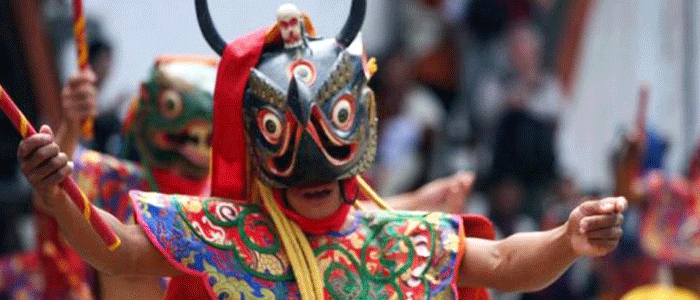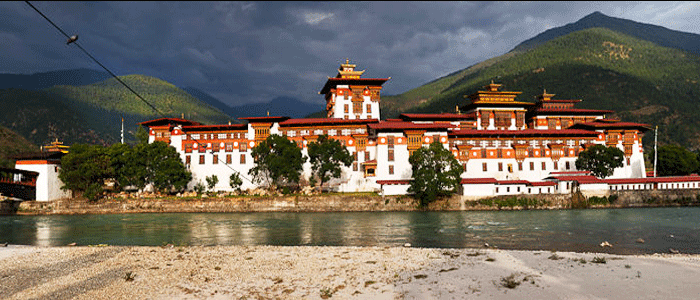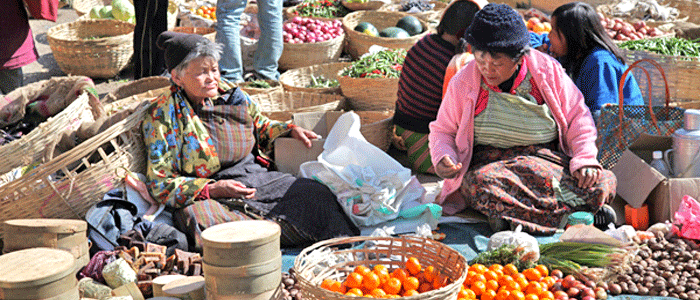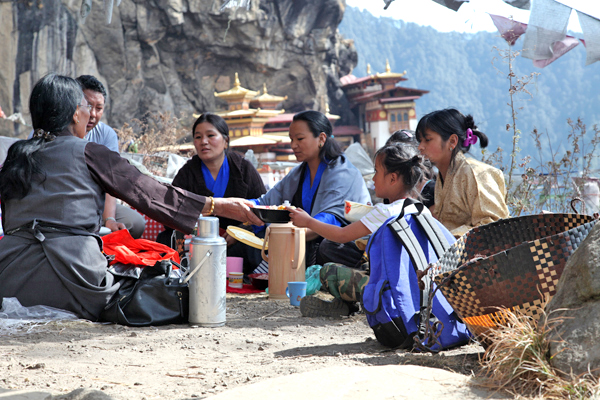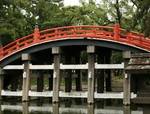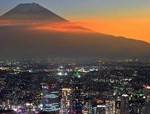Bhutan explorer and Bumthang Owl Trek
As Lonely Planet says Bhutan is no ordinary place. It is the last great Himalayan kingdom, shrouded in mystery and magic, where a traditional Buddhist culture carefully embraces global developments. Read all about it here: https://www.lonelyplanet.com/bhutan
Low Volume, High Value Tourism
The Bhutanese pride themselves on a sustainable approach to tourism in line with the philosophy of Gross National Happiness. Foreign visitors famously pay a minimum tariff of US$250 per day, making it seem one of the world’s more expensive destinations. However, this fee is all-inclusive – accommodation, food, transport and an official guide are all provided, so it’s not a bad deal. You don’t have to travel in a large group and you can arrange your own itinerary. What you won’t find is budget backpacker-style travel.
Surprising Bhutan
Bhutan holds many surprises. This is a country where the rice is red and where chillies aren’t just a seasoning but the main dish. It’s also a deeply Buddhist land, where monks check their smartphones after performing a divination, and where giant protective penises are painted beside the entrance to many houses. Yet while it visibly protects its Buddhist traditions, Bhutan is not a museum. You will find the Bhutanese well educated, fun loving and well informed about the world around them. It’s this blending of the ancient and modern that makes Bhutan endlessly fascinating.
The Last Shangri La?
So why spend your money to come here? Firstly, there is the amazing Himalayan landscape, where snow-capped peaks rise above shadowy gorges cloaked in primeval forests. Taking up prime positions in this picture-book landscape are the majestic fortress-like dzongs and monasteries. This unique architecture sets the stage for spectacular tsechus (dance festivals) attended by an almost medieval-looking audience. Then there are the textiles and handicrafts, outrageous archery competitions, high-altitude trekking trails, and stunning flora and fauna. If it’s not ‘Shangri La’, it’s as close as it gets.
Day by day Itinerary:
Day 1 Bangkok – Paro – Thimphu Distance 55km Duration: 1 ½ hr
Highlights: Spectacular views of Mt Everest (8,848 m), Kanchenjunga (8,586m) and Lhotse (8,414 m); and a literal adrenaline-pumping landing on the roof of the world.
Travel by Druk Air, Bhutan’s national airline, to Paro, the country’s only international airport. The flight is exhilarating to say the least, as the route traverses parallel to the mighty Himalayas enabling passengers to see the world’s highest peak, Mt Everest, and many more. The descent affords a panoramic view of Bhutan’s foothills culminating into a thrilling landing at what is considered one of the world’s most challenging airports.
Meet your guide at the airport and head to the hotel for lunch. Devote the afternoon to sightseeing around the Paro valley famed for its natural beauty, historical monuments, agricultural farms and quintessentially Bhutanese village communities. Visit the National Museum, formerly a watchtower, and then the Castle on a Heap of Precious Jewels or Rinpung Dzong. Wind up the day with a stroll around Paro town. Evening drive from Paro to Thimphu is just under an hour. On the way stop at the Tamchoe Monastery view and chuzom the confluence of Paro and Thimphu River. Highlights: The power centre and the capital city of the Happy Kingdom. Also the hub of commerce and culture.
There are great many places to see in Bhutan’s capital. In the morning we will drive to Buddha Point, which provides a spectacular 360-degree close-quarter view of entire Thimphu and the adjoining areas. This is the site of the world’s tallest statue of Shakyamuni Buddha. Our next destination is the Memorial chorten of Third king of Bhutan the Jigme Dorji Wangchuk, visit the 12th century Changangkha Temple, Takin Zoo and the viewpoint at Sangaygang. On our way back, we stopover at a nunnery, the Folk Heritage Museum and the Textile Museum.
We will proceed to Tashichho Dzong, a 17th century castle-fortress which today houses the offices of the King, Chief Abbot and government ministries. We will also take the opportunity to see the nearby parliament complex, the School of Arts and Crafts, vegetable market, and then spend the rest of the day watching an archery match and strolling around the town. Overnight at hotel
Day 2 Thimphu – Pumakha Distance: 76 km Duration : 3 hours
Highlights: A panoramic view of the snow-capped eastern Himalayas and a multitude of alpine flowers and birds; Bhutan’s ancient capital and Temple of Fertility.
The three to four-hour drive from Thimphu traverses thorough a constantly changing kaleidoscope of vegetation, waterfalls, flowers, mountains and meadows. In about 45 minutes we will reach the famous Dochula pass (3,100m) where on a clear day we can see the entire eastern Himalayan range, teeming with 6,000m to 7,554m snow-capped mountains. The pass also known for its abundant species of extremely beautiful flowers has 108 Buddhist stupas exquisitely built around a mound, adding to the natural splendor of the place.
From the pass we descend to the sub-tropical valley of Punakha. Punakha served as the ancient capital of capital and still possesses the country’s main treasures in the form of Buddhist relics. Resembling a gigantic ship on an ocean floor from afar, and girdled by two (Male and Female) rivers, the castle-fortress also represents the best specimen of Bhutanese architecture.
After lunch in a small nearby village together with a rural farming household, we will walk along a footpath flanked by an endless view of ripening paddy fields to the Temple of Fertility – Chimi Lhakhang. This temple, built in the 15th century to honour the “Divine Madman”, a saint iconoclast who is also associated with phallus worship, attracts barren couples from all over to receive fertility blessings from an anointed phallus. Night halt in Punakha
Day 3 Punakha – Gangtey Distance: 78 km Duratio: 3hours
After breakfast drive to Gangtey wich is 78km it’s about 3hours via Wangdue Phodrang, the road is gradually up to Lawala pass (1100 feet) passing through Nobding village, and the ground is covered with high altitude dwarf bamboo, spectacular view of the snow-cap mountains, areas mostly cover with rhododendrons flowers, Magnolia, fir and pine forest. Phobjikha valley is at 3,000m in the Black Mountains range. Phobjikha is one of the most beautiful valleys in Bhutan and is the home to the very rare black-necked crane. The birds migrate from Tibet to Bhutan to winter here (from October -March). Visit Gangtey Gompa, one of the oldest Nyingmapa monasteries that look like a small Dzong. Night at Phobjikha
Day 4 Gangtey – Bumthang via Trongsa Distance: 188km Duration: 5 – 6 Hours
Highlights: Landscape, semi-nomads, diverse vegetation, and sighting of high altitude birds and animals enroute
Before heading for Trongsa in central Bhutan, we will visit the ruins and reconstruction work underway at Wanduephodrang, a fortress that was built in 1638 but was gutted in 2012.
If lucky, we might be able to sight the White-Bellied Heron cavorting on the riverbank. This is one of the rarest birds in the world.
The journey to Trongsa is a gentle climb, from the sub-tropical to the sub-alpine region with the highest point at Pelela Pass (3,300m) Consequently, we will notice the vegetation transform right before our eyes. To reach the pass, we will be skirting the periphery of the world’s largest winter habit of the exotic and the rare Black-Necked Crane. Pelela pass itself is historically significant as the boundary between eastern and western Bhutan before the country was unified. From Pelela we drop to the slightly lower valleys inhabited by the semi-nomads who live off yaks and whose lifestyles have largely resisted the forces of modernization.
Lunch at Trongsa. Enroute visit Trongsa Dzong. The biggest palace-fortress in the Kingdom reputed to have been built without using a single iron nail. This fortress has for centuries been the vanguard of powerful warriors, one of whom even led successful expeditionary forces against British-Indian army in the southern boundaries of his domain. We complete our Trongsa sojourn with a visit to the Watch Tower, Ta dzong, which is today preserved as the Museum of Bhutanese Kings.
The drive to Bumthang is initially an upward ascent for nearly half the journey till we reach the highest point at Yotong La pass (3,400 m). After a brief stopover to view the Black Mountain range, we drive towards Chumey entering the countries most expansive and beautiful valley known as Bumthang or a Meadow of Beautiful Vase. The Chumey are known for their skills in weaving the exquisite Yathra – clothing with intricate floral patterns woven out of sheep’s wool. Night halt in Bumthang.
Day 5 Stopover in Bumthang (start Bumthang Owl Trek 3 days)
Highlights: Monuments and structures which bring alive the exploits of saints and kings
This is the valley of myths and legends. One of the oldest surviving man-made structures in Bhutan, a temple dedicated to Buddha Shakyamuni, Jambay Lhakhang, was built in 639 AD as part of an oath by Tibetan emperor Songsten Gampo to subdue a demoness who lay spread-eagled across the Himalayas obstructing the teachings of the Buddha. Our next visit will be the Castle of the White Bird (Jakar Dzong) whose central tower (utse) is the tallest in Bhutan. The castle currently serves as the administrative centre for the district.
From Jakar, we drive a short distance to Chakhar and then to Kurjey Lhakhag. Albeit oblivious today, Chakhar is the site of the legendary “Nine-Storied Iron Castle” built by Sindhu Raja (king) in the 8th century and the innumerable myths surrounding it. Kurjey, meaning “Body Imprint on Rock”, has temples built against a wall of cliff. The imprint belongs to the 8th century saint Padmasambhava who mediated in a rock cave and, using his tantric powers as well as guile and guise, subdued the evils who tormented the people in the vicinity.
After lunch at our hotel, we drive to Tamzhing monastery which preserves the remains of the works of Terton Pema Lingpa who, in the 15th century, discovered many secret tantric teachings hidden by Padmasambhava. Pema Lingpa was an artist and sculptor extraordinaire but, more importantly, one of the five “King Tertons” – treasure revealers – of Vajrayana Buddhism. Our last visit for the day is the “Burning Lake” in Tang where Pema Lingpa, challenged by a local warlord, took a dive into a pool with a lighted butter lamp on his head and re-emerged from the lake with the lamp intact and holding a hitherto unknown statue in his hands.Night halt in Bumthang.
Bumthang Owl Trek (optional) itinerary:
Trek Day 1: Begin Trek; Jakar- Menchugang-Dhur-Schonath
Transfer by vehicle till the road head and start the trek at Manchugang. Visit the biggest village in Bumthang, called Dhur at an elevation of 2900m. The village consists of about 75 households with a recorded population of around 800 people. In this single village, there are three types of inhabitant called the Kheps (tax payers, with cattle and farmland), the Brokpas, (nomadic yak herders) and the third group having either. This village also use two different dialects; the usual Bumthang Kha and the Brokke (nomadic dialects). A walk above the village to get the overall view of the village is interesting. Climb down to the river where the traditional water-driven flour mill can be visited. This traditional water driven flour mill used to be a source of livelihood for the people of Dhur village. It has been abandoned after the intake channel was washed away by flash flood. The program has been rehabilitated as it symbolizes an authentic Bhutanese tradition. Continue the trek uphill through the blue pine forest and reach the camp at Schonath (3450m) in hemlock and juniper forest. The hauling of owls through the night is quite common, hence the name the Owl Trek.
Overnight in the tent camp.
Trek Day 2: Trekking through the virgin forest of huge temperate trees like spruce, hemlock, fir, birch and many species of rhododendron makes you breathe the real wilderness of Bhutan. Bamboos are the main undergrowth of this wild forest. During the months of April and May the rhododendrons are in full bloom. In about two hours, you will arrive at the Drangela Pass (3600m). Ascending the Kitiphu ridge brings you to an altitude of 3870m for the night camp. If weather favors you, have a wonderful view of the valley and the panoramic snow capped Himalayan Mountains. The highest mountain of Bhutan Gangkar Punsum (7541m) stands right in front of you when you are on the peak of Kitiphu. Overnight in tent camp.
Trek Day 3: Climb down to the monasteries of Zambhalha, Chuedak and Tharpaling which brings you to the religious life of monk hood, the historical Buddhist learning center. Chuedak monastery has 100 Avoloketeshvaras in the form of Chukchizhey (eleven heads) that you will see nowhere else in the country. Afternoon, walk along the ridge of Kikila and finally follow the traditional trek route between Trongsa and Bumthang (the Royal Heritage Trail). The best view of Jakar Dzong will end your three day trek with many interesting and unforgettable memories. Transfer to your hotel in Jakar (1hr) or Chumey (30min) or Trongsa (2hrs)
Day 7 Bumthang – Paro By domestic flight
If time permits sightseeing includes Paro Dong, National Museum and Dumtse lhakhang. Evening walk around town. Overnight in hotel
Day 8
Paro – Taktsang hike
Highlights: Hike to the Tiger’s Lair, the most famous Buddhist monastery in the Himalayas, built on a sheer rock face.
After breakfast, drive for half an hour and start hiking up to the temple that is renowned in the Himalayan Buddhist world as one of the most popular sites of pilgrimage. The five-hour round trip follows an ancient but oft-trodden footpath flanked by water-driven prayer wheels.
The temple, precariously perched on a hair-raising ravine about 1,000 metres above the valley floor, is considered sacrosanct as it was in a cave within this temple that the eight century tantric saint, Padmasambhava, subdued the evils who obstructed the teachings of the Buddha. The saint is believed to have come to Taktshang in a fiery wrathful form riding a tigress. Over the years, many Buddhist saints have meditated in and around the temple and discovered numerous hidden treasure teachings.
Visit the ruins of Drugyel Dzong enroute. The fortress known as the “Castle of the Victorious Drukpa”, is a symbol of Bhutan’s victory over the Tibetan invasions in the 17th and 18th centuries. We can also get a view of the sacred mountain, Jumolhari, along the way. On the way back to our hotel, we will visit the 7th century Kyichu Temple, believed to have been built on a place that resembled a knee of a giant ogress. Evening walk around the town for shopping and Cultural show at hotel. Overnight at hotel
Day 9 Paro – Haa – Paro Distance 65 km Duration : 2 hours
Haa remains one of the least visited areas in the country and retains the air of an unspoiled, primeval forest. This valley only opened to foreigners in 2002due to its proximity to the border with Sikkim and Tibet. This unspoilt valley harks back to a simpler, more traditional time, and its wooded hills give us an ideal setting for hiking and mountain biking. There are several pleasant walking trails in Haa and biking on the virtually traffic free valley to visit local areas of interest and village homes is an enjoyable way to spend the day.
Visit Chundu Lhakhang hike around the village and Lhagkhang Karpo
Chele La Pass which (3,988m) from which on a clear day the view sweeps away to Bhutan’s second highest peak, Mt Jhomolhari(7314m). Striding out along the Edelweiss covered ridge, we pass a sky burial site. We then descend for the two-hour hike through dense rhodendron forest, possibly sighting shaggy yaks, to Kila Goemba, an ancient nunnery nestled in a craggy patch on the mountainside below. Kila Goemba is a serene retreat for 32 Anims (Buddhist nuns) who lead an undisturbed life of religious studies, prayer and meditation. An hour’s descent from the monastery and we are back at the road and drive further down to Paro. Night at Paro
Day 10 Paro – Bangkok
After breakfast drive to Paro international Airport and fly out
Limited availability and subject to change and availability offer is only available 1st June 2018 to 31st August 2018. Terms and conditions apply please ask for details








